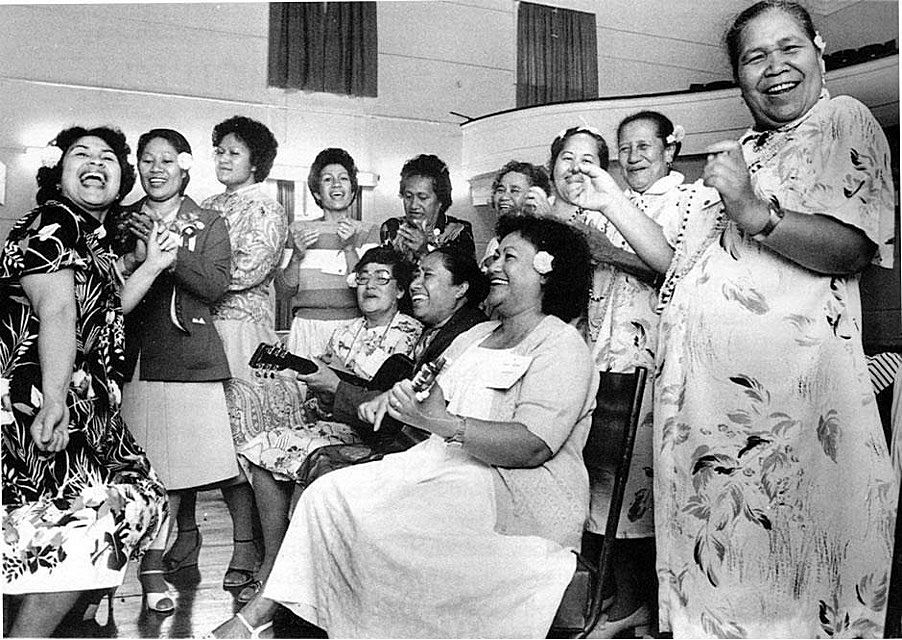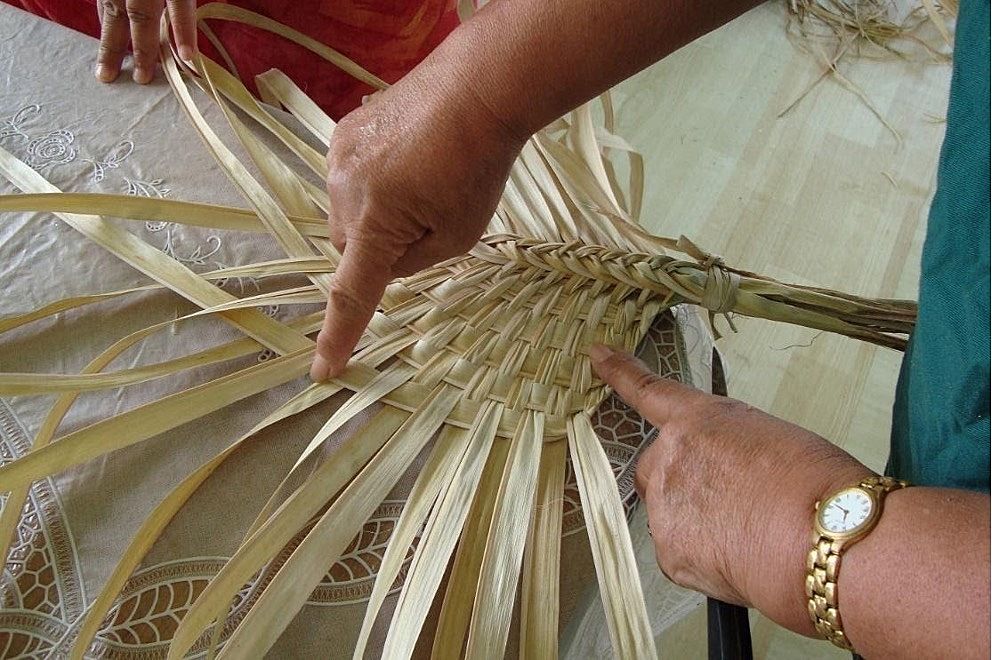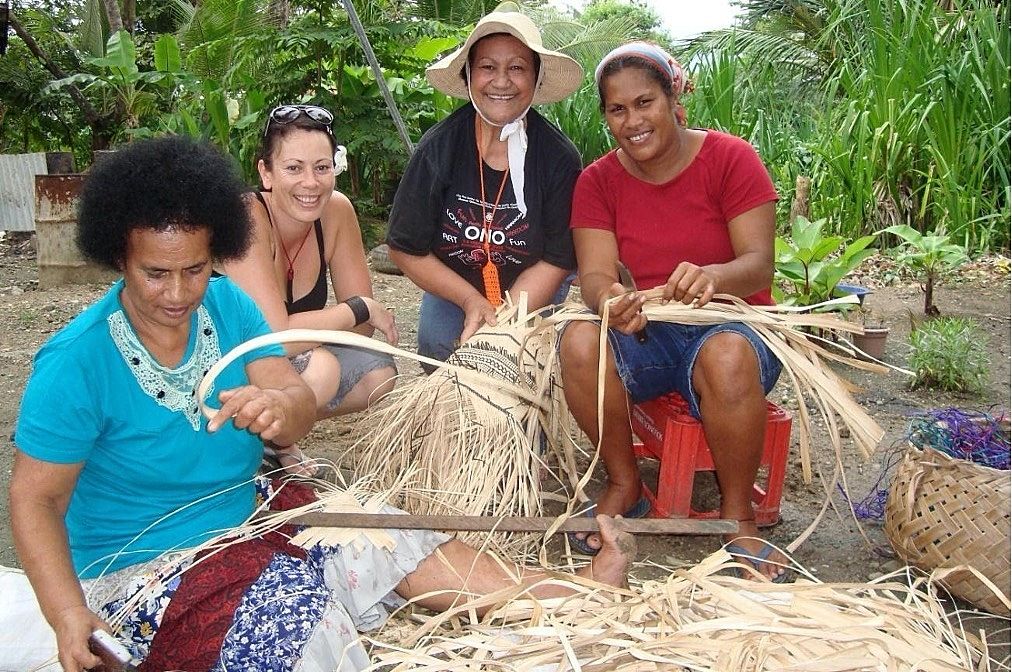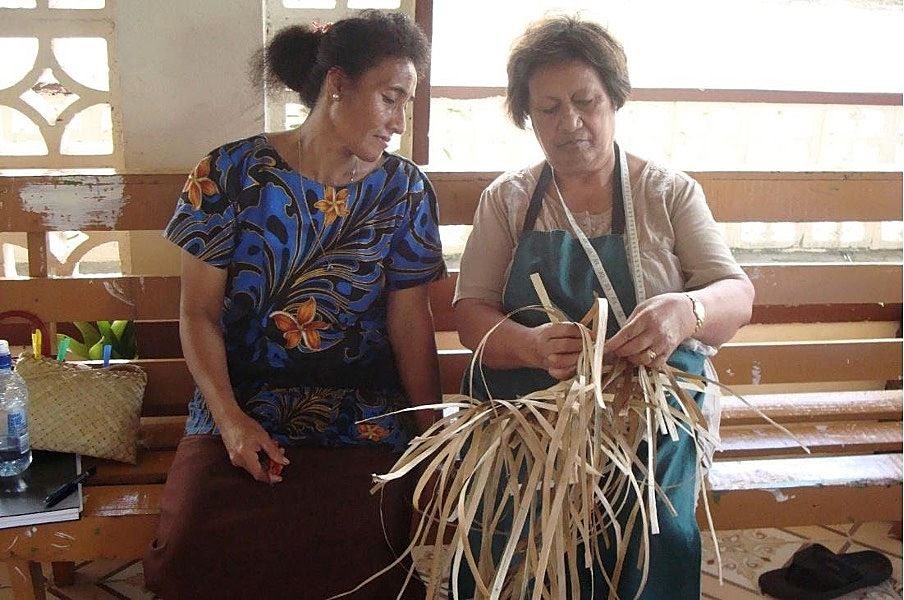“Whatever your hand finds to do, do it with all your might.”
For master artist Misa Emma Kesha, weaving feeds our mental, physical and spiritual wellbeing. With the help of her family, Misa Emma remembers her journey, all centred on the art of sharing and teaching.
We’re collaborating with Creative New Zealand to bring you the ground-breaking Pacific Arts Legacy Project. Curated by Lana Lopesi as project Editor-in-Chief, it’s a foundational history of Pacific arts in Aotearoa as told from the perspective of the artists who were there.
Lagi-Maama Academy & Consultancy had the honour of reconnecting with master artist Misa Emma Kesha QSM to talk about contributing to the Pacific Arts Legacy Project. As is our new norm, we initially connected via Zoom, together with her daughter Jules Kesha, who then proceeded to work with her mum on the first draft. There was so much to share, so a CV format seemed fitting to capture as much as possible, including key years – some of which she has elaborated on and others with just brief statements. The process led to further additions and refinement from Misa Emma’s other children, Peter, Rachael and Debra, before landing on the following story that has been gifted. Her grandson, Tenei Kesha, took the header image in front of the harakeke she planted. Misa Emma’s favourite Bible verse also inspired the title for this paper: “Whatever your hands find to do, do it with all your might, for there is no work, advice, knowledge or wisdom, in the grave where you are going.”— Ecclesiastes 9:10
A Master Artist
I was born in Western Samoa, 31 December 1940, during World War 2, when Samoa was under the governance of Germany.
My mother, Apoua Peai Fuatavai, is from Salelesi, and my father, Enosa Fuatavai, is from Fusi, Saluafata. Our home village, where I grew up, was Dad’s village of Fusi, Saluafata, Anomaa, Upolu, Samoa.
I would watch my mother and learn to weave fish, cubes and table mats out of leftover laufala
I would come home from school and look for my mother and grandmother. I would usually find them at the fale lalaga (the house of weaving). That is where the women of the village would gather and share their weaving skills. I would watch my mother and learn to weave fish, cubes and table mats out of leftover laufala (pandanus/flax). This was the beginning of my passion for weaving. I also learned to make more items to sell at the market with my mother for the tourist trade. Weaving was always in my blood.
My Fuatavai family are well known for our musical talents. I learned to play the guitar, ukulele and piano by ear, while some of my brothers learned and performed brass instruments. I am one of nine siblings; we always sang for evening worship and church, where we loved to practise our harmonies. Growing up within our Seventh Day Adventist Church gave me opportunities of leadership, where I enjoyed teaching in Sabbath school with the younger children and singing. In the school classroom, it was encouraged to learn and speak English. I had never imagined myself needing to have use of the English language, until my parents planned for me to make a life in New Zealand.
1958, October: Arrived in Auckland, New Zealand, on the Matua.
It was October 1958 when I arrived in Auckland City; I was only 17 years old. I was the very first of my family to travel to what was known as ‘the land of milk and honey’ back in those days. I came on the ship Matua, and my parents paid extra for my fare, so that I could share a cabin with two other girls. They didn’t want me to travel on the deck because it was said to be unsafe for young girls. When I arrived, I stayed in Ponsonby with my dad’s brother, Uncle To‘ulu Fuatavai. I shared a room with my cousin Melive and soon found work as a sewing machinist. I enjoyed using my hands and learning new skills. Melive and I loved buying the latest fashionable patterns and fabrics, to make dresses for church and sometimes wear them to the rock ‘n’ roll dances at the well-known Symonds Street dance hall.
Emma Kesha on the right, in the white blouse with her Indian friend, at Auckland Zoo, 1964.
Harry (Hira) Kesha in Manapouri, 1967.
1961: My husband Harry (Hira) Kesha and I were married in Auckland.
I met my Indian husband Harry (Hira) Kesha in 1960.
Harry was managing a grocery store where my cousin Carl worked. Carl would bring fruit and vegetables to Uncle and Aunty’s home. One day Harry came to drop Carl home, and walked in on Melive and I laughing and dancing in the dining room. Harry asked my cousin if he could take me to the movies. I wasn’t keen at first, but I said to Carl, in our culture he must ask my uncle for permission. Harry was very shy and it took him a long time before he got the courage to ask my uncle. When he did finally ask, my uncle agreed, with the condition set that I must be chaperoned by three of my cousins.
He paid for all five of us. A very expensive first date for Harry!
It was unusual for an Indian man and a Samoan woman to be married in the 60’s. Europeans would look at us sideways as we walked down the street
It was unusual for an Indian man and a Samoan woman to be married in the 60s. Europeans would look at us sideways as we walked down the street, but we would continue to smile and be friendly to everyone.
Emma (pregnant with fourth son Raymond) and Harry (Hira) Kesha, 1968.
Our eldest daughter was born in 1962, and when we heard that my father wasn’t well Harry supported me to take my first-born, Debra, at age nine months, to visit my family back in Samoa. We stayed for five months. Debra learned to walk in Samoa and we celebrated her first birthday with my family. They all loved and adored her, and she used to sleep between my parents at night time. Her first words were in the Samoan language.
Harry had organised a rental flat before we returned. On our second evening we came home to find that we were locked out and our belongings had been put outside! Our flat’s lock had been changed. The landlord said people in the other flats had complained to him that they didn’t want coloured people there. I stood there crying, with my baby in my arms and Harry trying to console me. We called our relatives from a nearby public telephone box and they told us to come and stay.
After that experience, we were both determined to work and save hard to buy our own home.
1965: Invercargill
Harry had relocated to Manapouri, in the South Island, for work. I followed later with my two eldest daughters, Debra and Jules, to Invercargill and stayed with my close relatives – the Salesa family. We then moved to be with Harry, and lived in Manapouri village with other workers’ families whilst Harry worked at the power station in West Arm. We returned to Invercargill in 1967, whilst Harry continued to work in West Arm and travel home on weekends off.
We achieved our goal of buying our first home in 1968 and paid cash (£6,000), through Harry's hard work, our sacrifice, and savings.
Debra and Jules were born in Auckland and we raised the rest of our children, three boys and our youngest daughter, in Invercargill.
1974
I returned to work in the sewing industry, at Knight Taylors, making suede and leather garments and sheepskin slippers.
Emma and her children, Invercargill, 1976.
1975 – present: P.A.C.I.F.I.C.A. Inc. foundation member
I began as a founding member of a national Pacific women’s organisation called P.A.C.I.F.I.C.A. in 1975. P.A.C.I.F.I.C.A. stands for Pacific Allied Council (of Women) Inspires Faith in Ideals Concerning All.
The organisation was started by Paddy Walker, a well-known Samoan-European woman. Paddy did a tour of New Zealand, speaking to Pacific women on how we came to this country, worked hard, married and had children. Pacific women never had a unified voice, and Paddy saw a need for P.A.C.I.F.I.C.A. to represent Pacific women and maintain their cultures, whilst living in New Zealand. Paddy felt that women could do anything, as they were the backbone of their families and centre of the household to initiate change. She encouraged women to stand up and form P.A.C.I.F.I.C.A. branches throughout New Zealand.
During national AGMs and conferences, I would teach my arts of weaving and ukulele playing to the women. I was a foundation member of the Invercargill branch, which I set up with a small group of women in 1975. I am a current member of Dunedin Central branch, which I set up in 1983. I held an executive position as South Island Vice President for eight years. My daughters Debra and Jules are both active within P.A.C.I.F.I.C.A. and have also held executive positions. Today, at age 81, I have been in P.A.C.I.F.I.C.A. for 47 years, since the age of 34.
women could do anything, as they were the backbone of their families and centre of the household to initiate change
During national AGMs and conferences, I would teach my arts of weaving and ukulele playing to the women. I was a foundation member of the Invercargill branch, which I set up with a small group of women in 1975. I am a current member of Dunedin Central branch, which I set up in 1983. I held an executive position as South Island Vice President for eight years. My daughters Debra and Jules are both active within P.A.C.I.F.I.C.A. and have also held executive positions. Today, at age 81, I have been in P.A.C.I.F.I.C.A. for 47 years, since the age of 34.
Image source: Alexander Turnball Library, EP/1983/0686. First day of P.A.C.I.F.I.C.A’s eighth annual conference, Wellington, February 1983. Standing, L–R: Celia Leota, Lifa Mulitalo, Ailini Williams, Tualapu Oliver, Ola Toimata, Tini Crombie, Ina Hellyer, Reura Karana, Tutai Tuaine. Seated, L–R: Mellie Likio, Sinatala Umaga, and Emma Kesha playing the ukulele.
Back row, L-R: Peter, Debra, Julia. Front row, L-R: Rachael, Emma, Harry (Hira) and Raymond. Seated in front: David, 1981.
1981: Dunedin
In 1981 we moved to Dunedin, as my husband was employed by Fletcher Challenge construction company and his work was based there.
It was at this time that I read an article about weaving being recognised as an artform. I was so excited! I read how it was a dream of Ngoi Pēwhairangi (Te Kumeroa Ngoingoi Pēwhairangi QSM – Māori composer of waiata), for weaving to become a recognised artform in Aotearoa. The Māori and South Pacific Arts Council (MASPAC), part of the Queen Elizabeth II Arts Council (and predecessor of Creative New Zealand), made this dream a reality by acknowledging weaving as an artform.
1983 – present: Dunedin Multicultural Weavers Association
I set up and created Dunedin Multicultural Weavers Association to share and teach the art of weaving.
In 1983 I decided to apply to MASPAC, and received funding to set up Dunedin Multicultural Weavers Association, which was open to all ethnic groups. I set it up so all cultures could share their artforms, and share Indigenous stories with one another. We connected with tangata whenua, using resources such as harakeke, shells, feathers and dyes.
1991
In 1991, Aotearoa Moananui a Kiwa weavers travelled to Tonga, and visited villages to share their weaving skills. We chose Tonga because it was the nearest Pacific island to New Zealand. Our Aotearoa weavers wanted to experience the island flax (laufala) and experience the dyes that were used in Tonga. We also had Tongan members in our organisation.
1996
In 1996, I took the Dunedin Multicultural Weavers to the Festival of Pacific Arts and Culture (FESTPAC) in Sāmoa. We were hosted by my family in Fusi and networked together, sharing weaving techniques with our village women and locals. Our group was interested in learning our Samoan culture, and to see the local women weaving in their own village setting. Our Māori and European members were amazed that we owned our own land and didn’t pay rent or lease to anyone. Everything was self-contained in the village.
Emma Kesha weaving a traditional Samoan fan, Fusi, Samoa, 1996.
Aotearoa Moananui a Kiwa Weavers Committee
After I created the Dunedin Multicultural Weavers group, I was invited by the Aotearoa Moananui a Kiwa Committee to join them and share my skills. I appreciated learning from tangata whenua and we taught students to respect the Aotearoa harakeke. In 1996 we held an exhibition at the Dunedin Public Art Gallery. Our Pacific weavers from around Aotearoa contributed their artwork and our Dunedin weavers created a round mat from harakeke and laufala to represent our Polynesian heritage. This round mat was gifted to the Dunedin Public Art Gallery to be preserved and exhibited for future generations.
Misa Emma Kesha sitting on the round mat made by the Dunedin Multicultural Weavers Association, and gifted to the Dunedin Public Art Gallery, 1996. This image was taken by Julia Kesha in 2014.
Round mat made by Misa Emma Kesha and the Dunedin Multicultural Weavers Association and gifted to Dunedin Public Art Gallery in 1996. This photograph was taken by Julia Kesha at Dunedin Public Art Gallery in 2014.
Misa Emma Kesha at EK Industrial Leather Specialist retail shop, Dunedin. Photo courtesy of the Kesha family, 1990.
1990–2008: EK Industrial Leather Specialist
I started my own business, EK Industrial Leather Specialist, after being made redundant as Managing Supervisor for the Government Training Centre – Rehabilitation League, which closed in 1989. I purchased all of the equipment and machinery from my department and I created a factory and retail shop in Dunedin. I was the only manufacturer of industrial leather goods in the South Island. I specialised in carpenters’ aprons, electricians’ pouches, welders’ jackets, scaffolders’ belts, St John ambulance leather belts and pouches, wallets, bags, school uniforms, Pacific clothing, sheepskin slippers, giftware, clothing made to order and repair services. I serviced businesses throughout Aotearoa, covering safety gear and equipment for hardware, safety and building businesses.
Misa Emma Kesha with some of her woven products, EK Industrial Leather Specialist retail shop, 2006.
1990s – present: Participation on boards
I realised the importance of being a member on several boards, to advocate for our creative and Indigenous communities and to ensure we had a voice at the board table. Below are some of the boards and trusts of which I was a member.
1992–1995: Pacific Island Business Trust
Board member and South Island representative as a business owner.
1992–1995: Queen Elizabeth II Arts Council
Pacific Island Arts Committee member.
1998–2001: Creative New Zealand (formerly Queen Elizabeth II Arts Council)
Pacific Island Arts Committee member.
1998: Received chieftain title in Samoa
I received the title ‘Misa in recognition of my and husband Harry’s ongoing financial support to provide for my family living in Samoa. This was the first time that a woman had been made a chief in my family.
1998–2008: Pacific Trust Otago Board and Founding Member
1998 – present: Samoan Advisory Council of Chiefs
I hold a significant position in this advisory council, with the ability to articulate and advocate for the Pacific community in Dunedin.
1998 – present: Christchurch Pacific Arts Festival (organised by Pacific Underground)
I was invited to present weaving workshops over a period of ten years in Christchurch.
I nominated myself to attend, as no weavers had been included in their selection. Everyone laughed and clapped, agreeing that it was right for me as the first weaver to attend this event
2000: 8th Festival of Pacific Arts and Culture, Noumea, New Caledonia
I asked an important question to the Pacific Arts Committee: “Why are New Zealand Pacific citizens not representing New Zealand in this arts festival?” This question was forwarded to Creative New Zealand. They agreed with my question and told us to select Pacific artists to attend the festival in New Caledonia. I had to initiate weaving to be included as an artform for this event. I nominated myself to attend, as no weavers had been included in their selection. Everyone laughed and clapped, agreeing that it was right for me as the first weaver to attend this event. I also selected Matafetu Smith, a Niuean weaver from Auckland, to accompany me.
I believe that this paved the way for the inclusion of Pacific artists in the New Zealand delegation to FESTPAC, from this first time in 2000 right up to the present day.
Exhibition of mat titled My Life Journey and woven kete by Misa Emma Kesha at the end of her Artist in Residence term, Macmillan Brown Centre, Canterbury University, Christchurch, 2002.
2002: Artist in Residence, Macmillan Brown Centre for Pacific Studies, Canterbury University, Christchurch
I was the Creative New Zealand/University of Canterbury Macmillan Brown Centre for Pacific Studies Artist in Residence, where I created the artwork titled My Life Journey, using laufala and harakeke to make a 365.76cm x 91.44cm wall hanging.
This work was based on my journey from Samoa to Aotearoa, and also represents my husband and six children. This was the best time of my life, when I was able to weave and solely focus on my art for six months. I utilised materials such as shells and feathers that women use in Samoa, and I added paua shells to represent Aotearoa. I made new friends with other artists and gained many new experiences and lifetime memories. My work liberates my passion without restriction. I like to explore past and modern images that reflect my belief in unity and in the mutual community.
2006–2012: University of Otago, Dunedin
Commissioned by the University of Otago to teach weaving workshops with the students.
2008: Pacific Advisory Council
Involved in strategic, policy and operational service.
2008: 10th Festival of Pacific Arts, Pago Pago, American Sāmoa
I attended and ran weaving workshops.
2010: Creative New Zealand Arts Pasifika Awards, Senior Pacific Artist’s Award
I was awarded the Senior Pacific Artist’s Award at the Creative New Zealand (CNZ) Arts Pasifika Awards. I received the award from Pele Walker, Chairwoman of the CNZ Pacific Arts Committee, at a ceremony that was held at the St James Theatre in Wellington.
Misa Emma Kesha (left) with Pele Walker, Creative New Zealand Pacific Arts Committee Chairwoman, 2010.
2010 – present: Weaving workshops, Dunedin, New Zealand
Runs beginner and intermediate level weaving workshops for community and various Pacifica events. The workshops are ongoing.
Misa Emma Kesha and the Governor General Sir Anand Satyanand, Government House, Wellington, 2011.
2011: Queen’s Service Medal (QSM)
I was awarded a Queen’s Service Medal (QSM) as part of The Queen’s Birthday Honours List, with the investiture taking place on 3 August 2011 at Government House, in Wellington. The QSM citation and acknowledgement was as follows:
For services to the Pacific community.
Misa Emma is a master weaver and has represented New Zealand at numerous art events. She has worked continuously for over 35 years to build organisations in weaving and the arts to support Pacific community events throughout New Zealand. She was a member of Creative New Zealand’s Pacific Island Arts Committee from 1992 to 1995, and has been an exhibitor, mentor and teacher for the Ministry of Youth, Sport and Cultural Affairs in Samoa. She was a member of the Pacific People’s Trust Board from 1998–2008. Since 1981, she has been a church leader and co-ordinator of the Women’s Ministry for the Dunedin Seventh Day Adventist Church.
2012: New Zealand delegation to the Festival of Pacific Arts and Culture, Honiara, Solomon Islands
I was invited to be part of the New Zealand delegation as the Senior Pacific Artist. I enjoyed sharing and exchanging weaving knowledge and techniques with women weavers in the Solomon Islands.
Back row, L-R: Eshan Dean, Andrew Sione, Hemi Lesatele, Posenai Mavaega, Hiliako Iaheto. Front row, L-R: Caren Rangi, Misa Emma Kesha, Tanya Muagututi‘a.
Misa Emma Kesha in the Solomon Islands with locals learning to weave, 2012.
2012: Samoan Seventh Day Adventist Women’s Ministry, Cairns, Australia
Invited as a guest speaker and shared on the theme “With Head, with Heart, with Hands”.
2013: Victoria University Wellington, New Zealand
Invited to speak about my artworks and run workshops for Pacific students.
2013: ADRA (Adventist Development and Relief Agency) Western Samoa
Ran weaving workshops throughout Samoa as part of ADRA.
Samoa, weaving workshop, 2013.
Samoan village Savaia weaving workshops, in the district Lefaga, 2013.
2015: Otago University, Dunedin, New Zealand
Invited to speak to Health Science students about weaving and my life journey.
2016: South Island P.A.C.I.F.I.C.A. mini conference, Christchurch, New Zealand
Involved in teaching a weaving workshop, titled Leading from the Heart.
2016 – present: Otago Museum, Dunedin, New Zealand
Initiated weaving workshops for the local community in Dunedin.
2017: The Breeze radio station, Dunedin, New Zealand
Video interview with Radio Host Damien Newell about weaving techniques.
2020: Otago Museum, Dunedin, New Zealand
Weaving artworks displayed at Otago Museum and also leading basic ukulele work-shop.
Puti puti (flower) arrangement gifted to Mrs Gillian Meredith, wife of The Honourable Susuga Tuila‘epa Sa‘ilele Malielegaoi, during their visit to Dunedin in 2018.
As a master weaver of my art, I share, teach, sing and tell stories. This heals broken hearts through laughing, crying, debating, sharing time and stories.
My Legacy and Skills
Weaving has opened up many doors and opportunities for me.
I have travelled throughout Australasia and the Pacific, sharing my weaving through workshops, mentoring and exhibitions. I believe that my talent is a God-given gift and needs to be shared with everyone from the heart. Sharing my knowledge has allowed me to make lifelong friends. This artform weaves us together as people and helps us to understand others and their cultures. Weaving is not just about the art itself, but the therapeutic properties of traditional communal activities, which feed our mental, physical and spiritual wellbeing. Many people are hurting and need healing.
Emma and Harry (Hira) Kesha at Emma’s graduation from modelling school, 1975.
*
This piece is published in collaboration with Creative New Zealand as part of the Pacific Arts Legacy Project, an initiative under Creative New Zealand’s Pacific Arts Strategy.
Lana Lopesi is Editor-in-Chief of the project.
Series design by Shaun Naufahu, Alt group.
Header photo by Tenei Kesha.






















